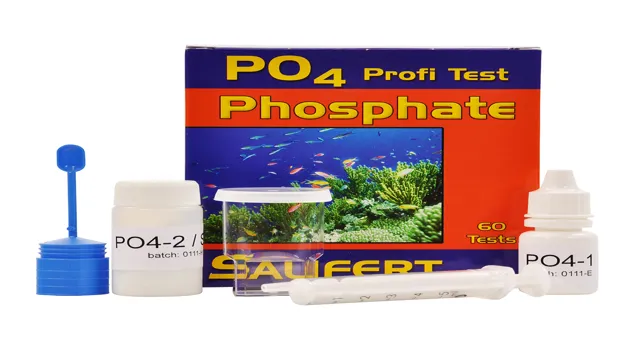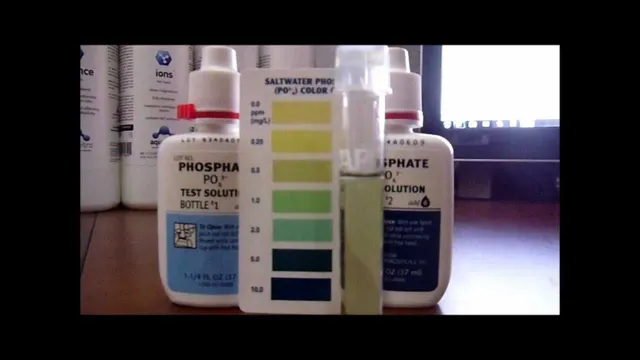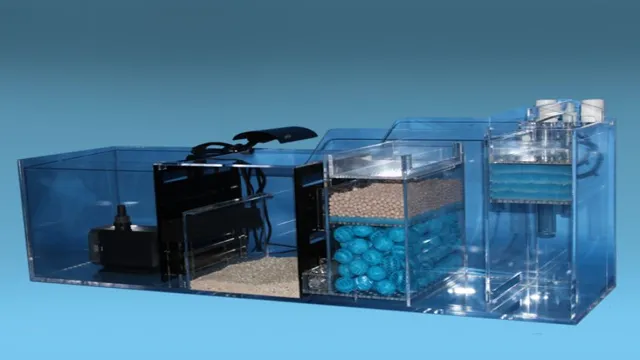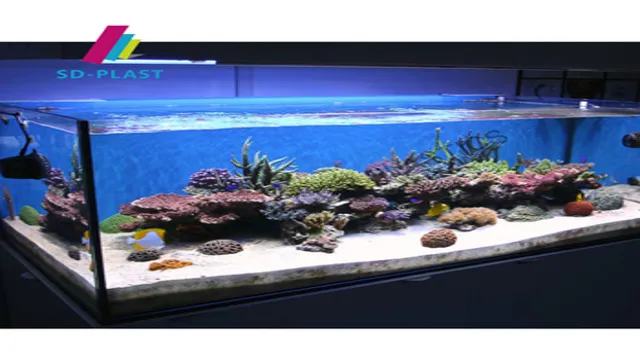How to Check Phosphate Level in Aquarium: A Comprehensive Guide for Healthy Fish Tanks

As an aquarium owner, keeping a healthy aquatic environment is imperative to ensure your finned friends are happy and healthy. One of the essential parameters to monitor is the phosphate level as an abnormal level of phosphate can lead to algae blooms, poor water quality, and unsightly water that can detract from the beauty of your aquarium. Checking the phosphate level is easier than you might think.
Some telltale signs, such as increased algae growth, can indicate a high phosphate level, but the only surefire way to know is to test it. In this blog, we will discuss all the ways to check the phosphate level in your aquarium, so you can keep your aquatic ecosystem healthy and thriving!
Why it’s Important to Check Phosphate Level
If you’re an aquarium hobbyist, then you know that maintaining a healthy aquarium is crucial for the survival of your fish and plants. One of the factors that you need to keep an eye on is the phosphate level in your aquarium. This is because excess phosphate can cause unwanted algae growth that can harm your fish and plants.
One way to check phosphate level in the aquarium is to use a phosphate test kit. These kits are readily available in pet stores and online, and they are easy to use. Simply follow the instructions provided, and you’ll be able to get a reading of the phosphate concentration in your aquarium within minutes.
By doing this, you can take necessary measures to bring down phosphate levels, like changing the water or reducing food intake. Regularly monitoring the phosphate level can help you maintain a healthy aquarium environment, which is essential for the well-being of your aquatic pets.
Effects of High Phosphate Levels
Phosphate levels can have significant effects on water quality and aquatic life. High levels of phosphate can stimulate excessive algae growth, which can cause a depletion of oxygen in the water and negatively impact aquatic organisms. This process is known as eutrophication and can have severe consequences for the ecosystem.
As such, it’s important to check the phosphate levels in bodies of water regularly. This is especially crucial in areas where human activities such as agriculture and wastewater treatment can increase the amount of phosphates in the water. By monitoring phosphate levels, we can prevent the negative effects caused by eutrophication and ensure a healthy environment for aquatic life.

Benefits of Maintaining Optimal Phosphate Levels
Maintaining optimal phosphate levels in your aquarium is crucial for the overall health of your aquatic pets. High levels of phosphates can lead to a wide range of problems for your fish, including poor growth rates, weakened immune systems, and reduced lifespan. Furthermore, too much phosphate can also cause unwanted algae growth, which can lower the oxygen levels and create harmful living conditions for your fish.
By regularly testing and adjusting phosphate levels in your aquarium, you can ensure that your aquatic pets are living in a healthy and thriving environment. Don’t overlook the importance of managing phosphates in your aquarium, as it can make all the difference in the world for your aquatic pets.
How to Test Phosphate Level in Aquarium
If you’re an aquarium enthusiast, it’s essential to keep an eye on the phosphate level in your tank. High levels of phosphate can cause excessive algae growth, which can harm your fish and aquatic plants. But how can you check the phosphate level in your aquarium? The easiest way is to use a phosphate test kit.
These kits provide accurate and quick results by measuring the amount of phosphate in the water. Simply take a water sample, add the testing solution, and wait for the color to change. The intensity of the color will correspond to the amount of phosphate present.
If the result shows a high level of phosphate, it’s time to take action. You may need to change the water, reduce feeding, or add some phosphate-removing media to your filter. Checking the phosphate level regularly is an important part of maintaining a healthy and vibrant aquarium ecosystem.
So don’t forget to test it regularly!
1. Use a Phosphate Test Kit
If you’re an aquarium enthusiast, then knowing how to test the phosphate level of your aquarium is essential. One way to do this is by using a phosphate test kit. This kit detects the concentration of phosphate in your aquarium water, which is crucial because high phosphate levels can lead to algae growth and harmful effects on your aquatic life.
Using a test kit is easy and straightforward. Simply follow the instructions and add the appropriate amount of test reagents to your water sample. The kit will provide you with accurate results in just a few minutes.
By monitoring and regulating phosphate levels, you can maintain a healthy and thriving aquarium ecosystem. So, don’t hesitate to invest in a test kit and stay on top of your aquarium maintenance.
2. Follow Test Kit Instructions Carefully
When testing the phosphate level in your aquarium, it is essential to follow the test kit instructions carefully. Most kits come with multiple steps and reagents that need to be added in a specific order and amount. It’s crucial to pay attention to each step and not rush through the process.
Testing is the only way to ensure that you are not overfeeding your fish or adding too many supplements, which can lead to excess phosphates. High phosphate levels can harm your aquatic animals and plants, leading to algae blooms, poor water quality, and reduced oxygen levels. To prevent this, make sure to use a reliable test kit and follow the instructions to the tee.
It’s better to take the time to test accurately and make adjustments than risk the health of your aquarium inhabitants.
3. Take a Sample of Aquarium Water
If you want to test the phosphate level in your aquarium, the first step is to take a sample of the aquarium water. You should use a clean container and fill it up with water from your aquarium. It’s essential to use clean and dry equipment to avoid contaminating the sample.
Once you have the sample, you can use a test kit to measure the phosphate level. Keep in mind that the ideal phosphate level for aquariums is between 0 and 0.5 mg/L, and anything above 1 mg/L can be harmful to your fish and plants.
A high level of phosphate can cause algae blooms, leading to poor water quality and the death of your aquatic pets. So, it’s essential to test your aquarium’s phosphate level regularly and take action if necessary to ensure the health and well-being of your aquarium inhabitants.
4. Add Reagents to the Sample
When conducting a water test for aquariums, it’s important to add the right reagents to get an accurate reading. In the case of testing for phosphate levels, you’ll need a phosphate test kit that typically comes with a set of reagents. To begin the testing process, you’ll need to add the first reagent to the water sample and swirl it to ensure it’s mixed evenly.
This reagent will change the color of the water depending on the level of phosphate present. Then, you will add a second reagent that will cause a reaction with the first reagent, indicating the precise amount of phosphate in the water. It’s crucial to follow the instructions provided by the manufacturer and use the correct amounts and sequence of reagents to ensure reliable results when testing your aquarium water for phosphate levels.
By using a phosphate test kit, you can stay on top of your aquarium’s water chemistry and ensure the health and longevity of your aquatic inhabitants.
5. Compare Results to Chart Included with Test Kit
If you want to ensure your aquarium is healthy and thriving, it’s essential to test the phosphate levels regularly. High levels of phosphate can lead to unwanted algae growth and even harm your fish. Testing the phosphate levels in your aquarium is simple with the help of a test kit.
First, you’ll need to collect a water sample and add the provided reagent. Then, shake the test tube and wait for a color change. Next, compare the color of the sample to the chart included in the test kit to determine the phosphate levels in your aquarium.
By regularly testing and monitoring the phosphate levels in your aquarium, you can take action to prevent any potential harm to your fish and ensure a clean and healthy environment.
Tips for Managing Phosphate Level in Aquarium
One of the most important things to consider in maintaining the health of your aquarium is managing the phosphate level. Phosphate is a compound that tends to accumulate in the water and can cause various problems, including excessive algae growth, decreased oxygen levels, and damage to aquatic plants and fish. So, how do you check the phosphate level in your aquarium? The easiest method is to use a phosphate test kit that you can purchase from a pet store or online.
This kit will allow you to measure the phosphate level accurately and determine if it’s within a safe range for your aquarium. Regularly testing your aquarium’s phosphate level and adjusting it when necessary can help prevent any potential issues and keep your aquatic pets healthy.
1. Regular Water Changes
Regular water changes are crucial to maintaining healthy phosphate levels in your aquarium. Phosphates are naturally present in fish food and waste, and can build up over time if not removed through regular water changes. A buildup of phosphates can lead to algae growth and poor water quality, which can harm your fish and other aquatic organisms.
To manage phosphate levels in your aquarium, it’s important to perform weekly water changes of 10-20% of the total volume in your tank. This will help dilute any excess phosphates and keep the water clean and clear. In addition to regular water changes, you can also use phosphate removing filter media or additives to reduce levels in your aquarium.
Monitoring your water parameters regularly and adjusting as needed will help keep your fish and plants healthy and happy.
2. Avoid Overfeeding Fish
When it comes to managing phosphate levels in your aquarium, one crucial tip is to avoid overfeeding your fish. Overfeeding results in excess food particles left in the water, which then decompose and release more phosphates into the aquarium. This can lead to algae growth and unhealthy water conditions for your fish.
To avoid overfeeding, only give your fish the amount of food they can consume in 2-3 minutes, and remove any uneaten food immediately. Another essential tip is to properly maintain your aquarium filters and perform regular water changes to remove any accumulated debris and excess nutrients. By taking these simple steps, you can maintain healthy phosphate levels in your aquarium and ensure the well-being of your aquatic pets.
3. Avoid Overstocking Aquarium
When it comes to managing phosphate levels in your aquarium, one of the best tips you can follow is to avoid overstocking. Having too many fish in one tank creates excess waste, which in turn can lead to an increase in phosphate levels. Keep in mind that phosphate is an essential nutrient for aquatic plants, so it’s crucial to maintain balance in your aquarium ecosystem.
It’s also a good idea to perform regular water changes to keep phosphate levels in check. Another tip is to consider using a phosphate remover in your filtration system, which can help reduce phosphate buildup. By following these tips, you can maintain a healthy aquarium environment and prevent potentially harmful algae blooms.
Remember, a little bit of prevention and maintenance goes a long way in keeping your aquarium thriving!
4. Use Phosphate-Removing Additives
If you’re struggling to manage the phosphate level in your aquarium, consider using phosphate-removing additives. These products are specifically designed to lower the phosphate levels in your tank, preventing algae growth and keeping your fish healthy. Most of these additives contain compounds like lanthanum chloride or aluminum oxide, which bind to the phosphates in the water and remove them from circulation.
Keep in mind that these products aren’t a long-term solution and should be used in conjunction with other maintenance practices, such as regular water changes and keeping your feeding under control. By taking proactive steps like using phosphate-removing additives, you can ensure that your aquarium stays healthy and beautiful for years to come.
5. Monitor Phosphate Level Regularly
Managing the phosphate level is essential to maintaining a healthy aquarium ecosystem. Excessive phosphate buildup has adverse effects on fish and plant life and leads to undesirable algae growth. Therefore, it is crucial to keep an eye on the phosphate levels in the aquarium regularly.
You can do this by using test kits that give an accurate reading of the phosphate level in the water. Once you identify the phosphate level, you can take steps to bring it down to a healthy level. One way to manage phosphate buildup is by using phosphate removers.
These remove excess phosphate from the water, preventing it from causing further problems. Additionally, feeding your fish a well-balanced diet and limiting the amount of food you feed them can also help control phosphate levels. By keeping a close eye on phosphate levels and taking proactive steps to manage it, your aquarium will flourish, and your fish and plant life will thrive.
Conclusion
In the world of aquariums, keeping phosphate levels in check is no small feat. But fear not! By testing your water regularly and taking proactive steps to reduce excess nutrients, you can ensure a healthy and happy tank for your finned friends. So, grab your testing kit, channel your inner marine biologist, and get ready to conquer phosphates like a pro!”
FAQs
What is the importance of checking phosphate levels in an aquarium?
Phosphate levels can affect the growth of algae and therefore impact the overall balance of the aquarium. High phosphate levels can lead to excessive algae growth, while low levels can result in stunted plant growth.
How often should I check the phosphate levels in my aquarium?
It is recommended to test the phosphate levels in your aquarium on a weekly basis, as this will allow you to monitor any changes and take appropriate measures if needed.
What are some common ways to test phosphate levels in an aquarium?
There are several test kits available that can be used to monitor phosphate levels, including colorimetric tests and digital meters.
What should be the ideal range for phosphate levels in an aquarium?
The ideal range for phosphate levels in an aquarium varies depending on the type of setup, but generally, it should be between 0.02 and 0.5 mg/L.
What are some common causes of high phosphate levels in an aquarium?
Overfeeding, decaying organic matter, and using certain types of fish food can all contribute to high phosphate levels in an aquarium.
How can I lower the phosphate levels in my aquarium?
Several methods can be used to lower phosphate levels, including regular water changes, using phosphate-removing chemicals, and reducing feeding.
Can high phosphate levels be harmful to fish?
While high phosphate levels are not directly harmful to fish, they can contribute to poor water quality and lead to health issues if left untreated.






